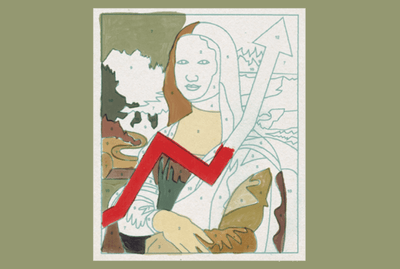
The History of Paint-by-Numbers
Share
In March 1951, shoppers of all ages descended on Macy’s in New York City’s Herald Square. Though the holidays were long over, eager customers packed in for a glimpse of the first in-store demonstration of a new craft project called paint-by-number. They swarmed the demonstrators and bought multiple sets without hesitation. Anyone present could see that the kit had mass appeal. As word of the frenzy reached the annual New York City Toy Fair taking place a few blocks away, orders began pouring in from retailers around the country.
There was just one problem: The customers were fake. Or mostly fake. The creators of the phenomenon would never know for sure. The rush on Macy’s was part of one of the most brilliant publicity stunts in the history of art or business. But the product itself was inspired by a different genius— Leonardo da Vinci.
When Dan Robbins, the 13th employee of Detroit-based Palmer Paint Co., read that da Vinci taught his apprentices the basics of painting by using numbered patterns on a canvas, he suspected the idea might have wider appeal. So he worked to put out a new product that would delight aspiring artists of all ages.
Unfortunately, no one wanted his Craft Master paint-by-number kits. Most retailers feared customers wouldn’t get the concept or wouldn’t want such a remedial art project. Finally, S.S. Kresge (later Kmart) took a chance and placed a big order. But due to a packaging snafu, the paints for two kits got swapped: Colors intended for “The Fishermen” ended up in boxes for “The Bullfighter.” Hobbyists stared at the blue-caped matadors battling green bulls, wondering where it had all gone wrong. Hit with demands for refunds, Kresge canceled all future orders.
Desperate to get its product back on shelves, Palmer Paint knew it had to act fast. Max Klein, the company’s founder, had an idea. Klein and Robbins started by asking the Macy’s toy buyer to let them demonstrate their kits in-store, promising that any unsold merchandise could be returned free of charge. Macy’s had nothing to lose by signing on. Then, Klein hired two reps to grease a few palms. In his 1998 memoir, Whatever Happened to Paint-By-Numbers?, Robbins recalls, “Max gave each of the reps $250, telling them to hand it out to friends, relatives, neighbors, anyone that would be willing to go to Macy’s and buy one of our Craft Master sets for $2.50.” That was $500—more than enough money to buy all the kits in the store.
Sure enough, the trick worked and “customers” flooded in. But Klein and Robbins forgot one detail: They didn’t keep track of who’d been given cash. In fact, they had no idea how many of the sets had been sold to their own plants and how many went to real customers caught up in the hysteria. Regardless, news of the sellout spread to buyers at the fair, and orders skyrocketed. Fake sales begat real ones, and paint-by-numbers turned into a full-blown fad.
Critics and serious artists scoffed at the idea that you didn’t need talent or training to make something worth hanging on a wall. But the rest of the country? It couldn’t get enough. Before long, paint-by-number landscapes and puppies had invaded the nation’s living rooms. Fan mail from adults and kids poured in; one housewife from Maryland wrote: “My home is disgraceful, and I sit here all day and paint. I’m spending my husband’s money, which I ought to be saving. Please send me a list of any new subjects you have.” By 1954, Palmer Paint boasted $20 million in sales of its Craft Master kits, 1,200 employees, and dozens of competitors. But the company did more than profit from a novelty; it showed that even if you paint yourself into a corner, there’s always a way to market your way out.
Now that you know a little bit more, you can have a look at and paint what you love!
